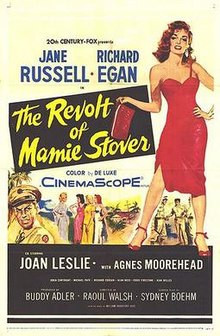| Reviews & Columns |
|
Reviews DVD TV on DVD Blu-ray 4K UHD International DVDs In Theaters Reviews by Studio Video Games Features Collector Series DVDs Easter Egg Database Interviews DVD Talk Radio Feature Articles Columns Anime Talk DVD Savant Horror DVDs The M.O.D. Squad Art House HD Talk Silent DVD
|
DVD Talk Forum |
|
|
| Resources |
|
DVD Price Search Customer Service #'s RCE Info Links |
|
Columns
|
|
|
Revolt of Mamie Stover, The
The Revolt of Mamie Stover, all but forgotten today, isn't half the film From Here to Eternity remains, but it's a not-bad variation. Where From Here to Eternity had been filmed in 1.37:1 standard size and black-and-white, Mamie Stover is in CinemaScope, color, and with four-track magnetic stereophonic sound.
Given the bum's rush and put aboard a Honolulu-bound freighter, Mississippi native Mamie Stover (Jane Russell) gives the cold shoulder to the ship's captain (Alan Reed, the voice of Fred Flintstone) and successful writer Jim Blair (Richard Egan). Mamie and Jim, the later already romantically involved with Annalee (Joan Leslie), fall for one another, but part ways upon arriving at Hawaii.
There, Mamie gets a job as a hostess at a dance club and bar owned by autocratic Bertha Parchman (Agnes Moorehead), where her girls must abide by a strict protocol or face beatings at the hands of manager Harry Adkins (Michael Pate). Earning 30% of the revenue generated by the tickets sold to sailors to buy watered-down drinks and companionship with Bertha's ladies, Mamie soon becomes the star attraction, socking away thousands of dollars.
But she loves Jim and craves respectability, and discreetly begins seeing Jim. The bombing of Pearl Harbor sends Jim packing overseas, fighting the Japanese, and while all of Hawaii is in a panic, cynical and ambitious Mamie sees a goldmine: she buys up land from the fleeing islanders for peanuts and rents their warehouses to the Army. Pretty soon Mamie is earning $4,000/month, but will Jim marry her when the war is over? Should she quit her lucrative if disreputable job at the club, and will the Hawaii's elite ever accept her?
The film follows the same basic plot as the same-named novel, written by William Bradford Huie in the early 1950s, part of a trilogy that began there and followed by The Americanization of Emily (1959) and Hotel Mamie Stover (1963). I haven't read the book but if the film of The Americanization of Emily is any indication, the novel was probably deeply cynical and critical of U.S. military policies in Hawaii, much like From Here to Eternity, and of ruthless war profiteers like Mamie.
The movie, of course, waters everything down to the point where the audience has to work a bit to read between the moral lines crudely drawn by the Production Code. Mamie is far more cynical and unsympathetic compared to Donna Reed's similarly compromised character in From Here to Eternity. Supposedly the role was originally intended for Marilyn Monroe, but it's hard to imagine her playing anything remotely like the character in the film, which Russell nails with impressive believability, right down to her Mississippi accent. (Less believable is the fiery-auburn wig she wears for most of the film.) After it was shot, The Revolt of Mamie Stover was apparently tinkered with extensively. Some scenes were dropped, others changed, including the ending which is quite bad and makes no sense given all that comes before it.
The picture's main attraction today is its extensive location work, showcasing a Hawaii before the mass tourist invasion that soon followed, and for its impressive Pearl Harbor attack sequence. Excitingly directed by Raoul Walsh with special effects supervision by Ray Kellogg, the sequence incorporates fairly good miniatures, composite shots combining strafing fighters with hundreds of fleeing extras. (The plates were reused in the later Kronos.)
Video & Audio
Twilight Time's Blu-ray of The Revolt of Mamie Stover is excellent, surprisingly sharp and lacking the distortions associated with early CinemaScope, and the color is good, though it looks digitally tweaked in an attempt to bring back its original hues. The DTS-HD Master Audio 2.0 and 5.1 mixes are excellent, even though it's less aggressive than other early CinemaScope titles. Optional English subtitles. The disc is region-free and limited to 3,000 units.
Extra Features
Supplements are limited to an isolated music and effects track, an original trailer gone magenta, in poor shape and in 1.85:1 format, and liner notes by Julie Kirgo.
Parting Thoughts
The Blu-ray format and studios like Fox, willing to put in the work to properly remaster even minor catalog titles like this, make The Revolt of Mamie Stover fun to watch, even if the movie itself is second-rate. Still, Recommended.
Stuart Galbraith IV is the Kyoto-based film historian largely absent from reviewing these days while he restores a 200-year-old Japanese farmhouse.
|
| Popular Reviews |
| Sponsored Links |
|
|
| Sponsored Links |
|
|
| Release List | Reviews | Shop | Newsletter | Forum | DVD Giveaways | Blu-Ray | Advertise |
|
Copyright 2024 DVDTalk.com All Rights Reserved. Legal Info, Privacy Policy, Terms of Use,
Manage Preferences,
Your Privacy Choices | |||||||













